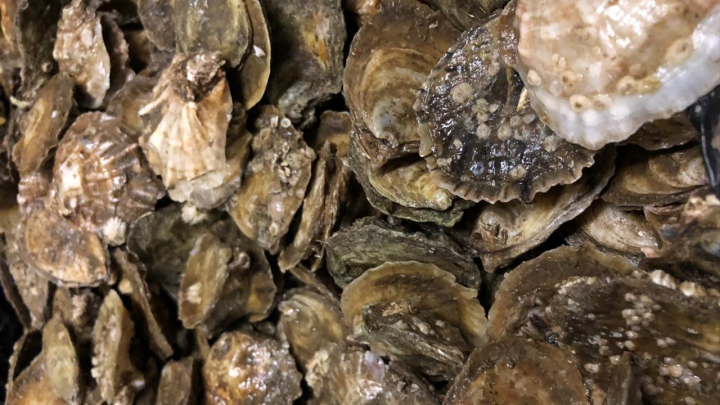Update on the AquaLeap Consortium Project
The AquaLeap consortium project's annual general meeting addressed its findings, progress, and next steps.
28/02/2022
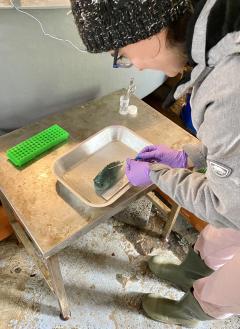
In February 2022, academic and industry partners from across twelve organisations met for the AquaLeap consortium project's annual general meeting. At its outset three years prior, the BBSRC and NERC funded AquaLeap project declared its mission statement: to develop and refine genomic tools and methods for improvements in aquaculture breeding and stock enhancement. The project spanned several different work packages and was focused on four key species:
- Atlantic salmon (Salmo salar)
- European flat oyster (Ostrea edulis)
- European lobster (Homarus gammarus)
- Lumpfish (Cyclopterus lumpus)
Originally, the project was expected to run from January 2019 to December 2021, but a no-cost extension shared across the Universities of Exeter, Stirling, Aberdeen, and Edinburgh now means that the project will continue to the end of 2022. This has given partners support in navigating delays caused by the Covid-19 pandemic and, furthermore, allows them to carry forward the last stages of their research--where their findings will be put to purpose within the industry. All partners were eager to convene and discuss their findings at the start of 2022 and to share updates on the progress they've made. Below, we'll discuss each of AquaLeap's internal work projects in further detail--and as Professor Ross Houston indicated at the start of the meeting, there have also been significant advances beyond these projects over the past year, which we will now recognize.
AquaLeap publications and profile
In March, the Scottish Knowledge Exchange Awards shortlisted some of the AquaLeap team members for commendation in their sixth annual awards. The awards note that the "Aquaculture Genetics Alliance", comprising AquaLeap members from Roslin, Stirling, Hendrix, and Cefas, commended the cooperation between industry, academic, and government partners and reflected on its benefits. This announcement helped raise awareness about the AquaLeap project, its mission, and the significant strides it has made since setting out in 2019.
You can find a full article on AquaLeap and the Knowledge Exchange Awards via this external link.
In October, AquaLeap teammates from Otter Ferry Seafish and the University of Stirling had their collaborative efforts highlighted as part of Aquaculture Europe 2021 in Madeira, Portugal. Doctor Alejandro Gutierrez presented the team's findings to a gathered audience, explaining how he and his colleagues undertook a genome-wide association analysis on 536 samples originating from 10 wild-origin lumpfish families for an end result of 3.2 billion paired end reads (resulting in identification and genotyping of genome-wide SNP markers which were mapped to the lumpfish genome). These results will help advance knowledge of the genetic basis of important production traits in lumpfish.
The Aquaculture Europe 2021 page is available via this external link.
In November, AquaLeap researchers published findings in the Genomics journal. The paper itself, entitled "The nedd-8 activating enzyme gene underlies genetic resistance to infectious pancreatic necrosis virus in Atlantic salmon", was made possible in large part by the project’s findings. AquaLeap team members from Cefas, Stirling, Hendrix Genetics, and the Roslin Institute collaborated to help make this work public alongside researchers from Uppsala University. The paper explains in detail how team members used CRISPR technology to find a gene affecting IPN-resistance in Atlantic salmon--a promising discovery for the industry and a colossal milestone for the project!
You can find the paper in Genomics Volume 113, available via this external link.
In addition, the AquaLeap team has published several review papers over the course of the past year, which have helped raise the profile of the project, and genetics in aquaculture more generally. These papers are accessible below via external links.
Developing Genomic Resources for European Lobster
Partners: The University of Exeter, the National Lobster Hatchery, Xelect Ltd, and the Centre for Aquaculture Environment, Fisheries, and Aquaculture Science
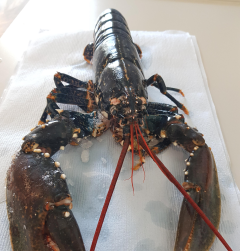
Doctor Josephine Paris, a postdoctoral research associate at the University of Exeter, gave a report on the team’s ongoing research into the European lobster. She broke the project down into three key tasks: generating a high-quality reference genome, estimating genetic parameters for growth traits, and investigating the relationship between epigenetic modifications and growth traits. She reported that she and her colleagues have generated over 9 million PacBio long reads and over 4.5 billion Illumina short reads for one male individual. The team has assembled and polished a genome at 1.78Gb which it then confirmed with a short-read k-mer analysis. Josephine noted that, while the genome could be over-collapsed due to its repetitive regions, it also contains high repeat content (at 46.53%). The team was able to compare their own findings with the genome assembly produced for the American lobster (Homarus americanus), which has been extremely valuable in their assessments and allows them to further investigate synteny with the American “sister”. Josephine noted that, alongside the partners listed above, the team received assistance from the University of Milan, the Roslin Institute, Xelect, and the Exeter Sequencing Service.
Josephine also outlined the progress the team has made since assembling their genome, much of which can be revealed publicly at the conclusion of the project. Additionally, the project she and her colleagues undertook alongside the National Lobster Hatchery allowed them to accrue RADSeq data on 188 individuals after quality control, forming model covariates which include information regarding claw type, depth, sex, and other factors.
This presentation accompanied an earlier report by Josephine as well as her colleagues Doctor Jamie Stevens, Doctor Tom Jenkins, Doctor Ronny van Aerle, and Professor Eduarda Santos which offers further detail into their ongoing research. This report is accessible below.
Developing genomic tools to support lobster aquaculture
Sequencing the flat oyster genome and analysing structural genomic variation in Atlantic salmon
Doctor Manu Gundappa and Professor Dan Macqueen jointly presented findings from their work within the project, which has dedicated its energy across two species. Alongside their progress on the genome-wide imputation of structural variation genotypes in Atlantic salmon, Manu, Dan and multiple colleagues have worked towards the assembly of a reference genome for the European oyster; Manu's presentation focused upon their progress.
The team first generated a high-quality contig assembly from Nanopore and Illumina data compiled earlier in the project, which showed excellent completeness statistics. This assembly was scaffolded to chromosome level using Omni-C technology and then annotated for gene and repeat content. The Roslin team (led by Doctor Carolina Peñaloza) also generated a flat oyster linkage map in collaboration with Arnaud Tanguy and his group based in France, which was used to confirm the quality of the chromosome level scaffolding. The team has further carried out a pilot investigation of the structural variation (SV) landscape in the flat oyster genome, largely undertaken by Masters student Jiayi Huang. Using both short and long read technologies, the team discovered around 10,000 high-confidence SVs in the flat oyster genome. Finally, Manu has performed comparative genomic analyses to reveal gene families that have been expanded during flat oyster evolution.
The team is proud to have completed their high-quality reference genome for European flat oyster, which will be released to the public in March, with a publication expected later this year.
Doctor Manu Kumar Gundappa has also produced a full written report of the team's work, which is available in full below.
A new reference genome assembly for Ostrea edulis
Genomic tools to enable selective breeding of Lumpfish
Partners: The University of Stirling and Otter Ferry Seafish Ltd
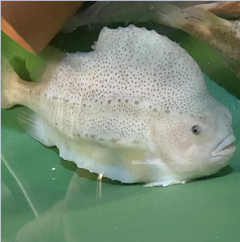
Doctor Alejandro Gutierrez from the University of Stirling represented his colleagues and gave a report on their research into innovations in lumpfish (Cyclopterus lumpus) breeding. Alejandro assumed control of the project in 2021, taking over from the team's previous lead, Andrew Davie; he reported that the team's goal within AquaLeap's one year project extension is to develop and accrue information on SNPs for geographic origin and to then design low-density SNP panels for cost-effective genomic selection and parentage assignment. In this regard, the lumpfish poses a different breeding goal to many other aquaculture species, as researchers hope to determine how they might slow growth, as lumpfish (a useful agent for biological control) feed on sea lice less effectively once reaching a particular body size.
Working alongside Otter Ferry Seafish, the team selected 10 broodstock families and genotyped 4 with RADSeq, facilitating an association study for growth including weight and standard length. Sex-associated markers were also identified, and the team can now accurately predict sex using 2 SNPs. The team will continue to study this region of the genome. The team picked around 700 lumpfish and screened candidate broodstock for fast and slow growth genotypes in order to propose targeted crossing and family creation. The genotyping results thus far are extremely promising, with many details still forthcoming.
Alejandro explained that the design of the team's low-density SNP panel contained both confirmed growth associated markers and gender QTLs focused on marker development; it is potentially usable for determining relatedness, genetic diversity, and fish origin. Looking at the rest of 2022 and beyond, the team has a colossal amount of data to analyse and is presently performing these genetic analyses. They will be hiring a postdoctoral researcher to assist with this work. It may be more manpower will be needed as well based on these results.
While the team has faced challenges due to COVID, they've also developed innovative solutions to many of the problems caused by lockdowns and delays. Collaborating with Professor Carlos Garcia de Leaniz and Professor Sofia Consuegra del Olmo at Swansea University has helped provide samples from 15 locations; these samples have now been genotyped using KASP assays with LGC for around 500 SNPs. The team received results from the first 250 fish in the last week of January 2022. Looking forward to the rest of the year, Alejandro and his colleagues have an impressive amount of data to utilise, and they've already begun using it to undertake genetic analyses.
Understanding the genetics of Bonamia infection or resistance in European oysters
Partners: The University of Edinburgh and the Centre for Environment, Fisheries, and Aquaculture Science
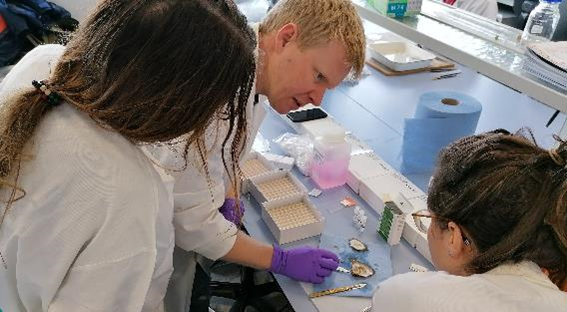
Doctor Tim Bean from the Roslin Institute and Doctor Chantelle Hooper from Cefas presented jointly on their own work project, which is fixed upon the study of Bonamia ostreae, a parasitic infection which has had devastating impact on the European flat oyster (Ostrea edulis).
Chantelle spoke about the lab-based Bonamia Ostreae challenge. While Ostrea edulis has been struck by significant population reductions as a direct result of Bonamia, restoring the species is particularly valuable for reconstructing marine habitats, making the species' ability to resist Bonamia a key priority. Chantelle described their project's design, which incorporated a cohabitation challenge across 1,000 individuals, all of which were tagged prior to tank introduction. Over the course of the challenge, each tagged oyster which died was the subject of a gill biopsy, and each oyster underwent inspection thrice per week over 200 days; water samples were also taken at these times. Of those individuals present, 65% died.
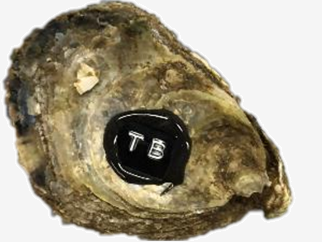
This process took place towards the beginning of the AquaLeap project; Tim and Chantelle described the research process undertaken by fellow Roslin teammate Doctor Carolina Peñaloza, whose work was instrumental in this project. The process made use of five tanks and provided qPCR data for 859 individuals (many of which were mortalities). Of the 842 individuals genotyped at 11,812 SNPs, 817 individuals were genotyped at 9,210 SNPs after quality control. Curiously, their findings indicated no visible correlation between an individual's parasite load and its odds of survival, meaning mortality of the oysters is likely unrelated to whether or not they have a specific abundance of the parasite! While unexpected, this discovery may be extremely useful, as it may suggest that parasite load is the most viable phenotype for assessing disease resistance. Chantelle also noted that this continued study--as well as additional field testing to measure heritability traits--was made possible by input and support from other universities and partners such as the University of Exeter, the University of Portsmouth, and the Blue Marine Foundation.
Carolina, Tim, and Chantelle produced a report on their work, offering further insights into the process they undertook in the project (and into their exciting findings). The report is accessible below.
Towards genetic resistance to Bonamia in European oyster
Improving CRISPR genome editing in salmon cell lines and embryos
Partners: The University of Edinburgh and Hendrix Genetics
Doctor Yehwa Jin, a Postdoctoral Research Fellow at the Roslin Institute, described her own work package and her colleague's efforts to optimize gene editing techniques in vitro for salmonid species. To do so, Yehwa and her colleagues utilised different Cas9 concentrations, different electroporation settings, and use of Cas12a in lieu of Cas9 which resulted in efficient editing in multiple salmonid cell lines. It was also shown that various genome editing methods including electroporation of plasmid DNA, lentiviral transduction, and electroporation of the Cas9 RNP can be successfully applied in salmon primary embryonic cells. Additionally, Yehwa trialed microinjection across the zygote’s early developmental stages, and cross-referenced her findings by hours-post-fertilisation, cell stage, and Cas9 format, which significantly improved the editing frequency in salmon and trout.
Yehwa also spoke about the team's goal of genome editing for resistance to viral disease in salmon, which has already produced published results as of last year. These earlier studies allowed Yehwa and her colleagues to produce knockout cells and investigate the impact on disease susceptibility by checking the viral loads and infectivity between wild type and the knockout cells. Yehwa has produced a report on her work up into 2022, which is available below.
Improving CRISPR genome editing in salmon cell lines and embryos
Yehwa described some of the team's next steps, which include continued testing and comparisons against rainbow trout cells. Once these further experiments have advanced sufficiently, material will be shipped to Cefas for a disease challenge and further testing.
This brings us to the end of the presentations given during the AquaLeap 2022 AGM. Discussion continued, however, with individual project teams considering one another's findings and proposing ways in which they can collaborate more closely over the coming year. It is notable that, as many of the presenters mentioned, these teams have already begun collaborating across different work projects as was not anticipated in the original project's mission statement. However, this cooperation has been enormously useful across the work projects, and 2022 offers many more exciting opportunities to join together than help further AquaLeap's research and reach within the industry and academic communities!
More Information
You can find more information about the AquaLeap project here through our website and elsewhere online:
This article provides details from our previous Annual General Meeting in 2021.
This article provides more information on the start of the AquaLeap project.
This newsletter from 2020 shows the progress made by the AquaLeap project in its first year.
The AquaLeap project is a collaboration between the following partners:
-
The Scottish Aquaculture Innovation Centre
-
Otter Ferry Seafish Ltd
-
Tethys Oysters Ltd
-
The National Lobster Hatchery
-
Hendrix Genetics
-
Xelect Ltd
-
The Centre for Environment, Fisheries and Aquaculture Science
-
The University of Exeter
-
The University of Aberdeen
-
The University of Edinburgh
-
The University of Stirling
We are proud to be part of this exciting project alongside so many excellent partners, and we look forward to the findings and the activities of the coming year.
